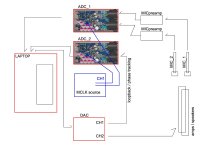the Cosmos DAC is under development, I try to use ES9039Pro but have no stellar result yet for such money($55/chip). I want to try 9039Q2M instead.
The Scaler, as I see, not too many people waiting, too low demand to start the production.
The Scaler, as I see, not too many people waiting, too low demand to start the production.
This may be a viable alternative https://www.ti.com/lit/ds/symlink/d...ttps%3A%2F%2Fwww.ti.com%2Fproduct%2FDAC11001B Not cheap and a different interface but really excellet performance to 100 KHz.
the Cosmos DAC is under development, I try to use ES9039Pro but have no stellar result yet for such money($55/chip). I want to try 9039Q2M instead.
The Scaler, as I see, not too many people waiting, too low demand to start the production.
If SCALER is completed then maybe you might be interested in sort of GB for people that will mount / solder pcbs themselves?
you provide pcbs and BOM rest is in our hands 🙂
Aren't we talking ADC here 🙂This may be a viable alternative https://www.ti.com/lit/ds/symlink/dac11001b.pdf?ts=1680628774261&ref_url=https%3A%2F%2Fwww.ti.com%2Fproduct%2FDAC11001B Not cheap and a different interface but really excellet performance to 100 KHz.
//
For a high performance DAC as a source. The TI specs are quite good. And since its a different technology some of the potential hidden errors in audio DAC's may get revealed by comparison. It can clock at sample rates of as high as 30 MHz, something that opens other interesting aspects to explore. For straightforward HD testing an active or passive LP filter would get you more that enough performance usually, however confined to specific frequencies. One issue with ADC's is that the relationship between the sample clock and the stimulous can hide bad bits. However analog oscillators are not stable enough to check close in issues and can drift enough in a high res measurement to hide harmonics across several bins reducing their amplitude. No easy answers.
Um, if you actually have a real measurement system, ADC,DAC, and notch filter you will have more people interested in your products. I for one have told many collegues about your ADC and notch filter. Everyone comes back with what's the source? Just saying what I know on my side.the Cosmos DAC is under development, I try to use ES9039Pro but have no stellar result yet for such money($55/chip). I want to try 9039Q2M instead.
The Scaler, as I see, not too many people waiting, too low demand to start the production.
Mark
I do think that people are willing to pay for a few more dB:s of lower THD or THD+N.the Cosmos DAC is under development, I try to use ES9039Pro but have no stellar result yet for such money($55/chip). I want to try 9039Q2M instead.
The Scaler, as I see, not too many people waiting, too low demand to start the production.
This is just a proto, I have no plan to add the buffer for a few reasons(*) but I'll probably keep these footprints for DIYers.
* reason #1 is the voltage limiting and power consumption(to get the same 10Vrms I need +/-16Vdc rails), the reason #2 is a high-impedance input protection which is more complex than just 2 diode clamps. Reason #3 is the cost of semiconductors. #4 I'd like to give smart people some advantages - more smart people around me = better life quality.
* reason #1 is the voltage limiting and power consumption(to get the same 10Vrms I need +/-16Vdc rails), the reason #2 is a high-impedance input protection which is more complex than just 2 diode clamps. Reason #3 is the cost of semiconductors. #4 I'd like to give smart people some advantages - more smart people around me = better life quality.
Also, a slightly improved crosstalk <-150db@1kHz(breathing around -153db, thanks to 4 layers PCB) when all unused inputs are terminated-shorted. And 10kHz H3@-.5db now is <-120db, if the H3 minimized for 1kHz. Two USB-C sockets, one for data, another for power. The ISO barrier + constructive capacitance(PCBA in the housing) is 9pF. Data USB-C cable with fixture! (thanks StaticV3 for the suggestion).

Last edited:
hi,
would it be possible to add "feature" to upcoming ADC? --> possibility to link two (or more) ADCs to sync them/ via MCLK (?
opt.A with external MCLK generator
apt.B connecting two boards with single wire for syncing (much easier from user perspective)
it would allow users option for using two or three measurement microphones and phase tracking (from DAC). i know REW can do acoustic timing, but this might expand funcionality a bit
would it be possible to add "feature" to upcoming ADC? --> possibility to link two (or more) ADCs to sync them/ via MCLK (?
opt.A with external MCLK generator
apt.B connecting two boards with single wire for syncing (much easier from user perspective)
it would allow users option for using two or three measurement microphones and phase tracking (from DAC). i know REW can do acoustic timing, but this might expand funcionality a bit
Attachments
At least two mics for differential measurement systems like ARTA. There is good reason to use a two mic system!
- Home
- Vendor's Bazaar
- Cosmos APU a notch+LNA $70 to outperform APx555b for $30,000
